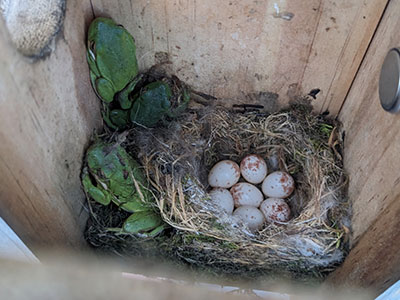The cost of housing goes interspecies: Skyrocketing rents bring biodiverse tenants
April 17, 2025

Birds and frogs living together under one roof? That often is not the case. While frogs have been known to take over an existing birdhouse or box as a place to rest, the chances of that happening are low. What is rarer is to find frogs cohabitating within an active nest - in this case, a family of Carolina Chickadees.
That small chance became a reality when Pete Peterson went to check on the boxes on what was to be a routine Monday morning in April.
Peterson, a recent graduate of the VCU Center for Environmental Studies (CES) and a Ph.D. student this fall in the Integrative Life Sciences program, was on the water checking for bird activity at the numerous boxes Rice River Center avian researchers have placed around the property.
Peterson is no stranger to bird behavior. He has analyzed 24-years of data on the Prothonotary Warbler (PROW), exploring the impact of temperature and precipitation on the timing and duration of the incubation period. He has also monitored female incubation behavior over the past two years – assessing whether it changes with temperature – to speculate how females may respond to climate change and potential reproductive consequences. Currently, he is charged with coordinating field data for the PROW project, where over 90 man-made nest boxes are continuously monitored across Rice Rivers Center and Deep Bottom Park. They are checked for nesting attempts and to monitor reproductive success over time. The project is led by VCU Faculty Drs. Catherine Viverette (Rice Rivers Center) and Lesley Bulluck (CES).
What he found prompted him to alert the team to this developing situation, and is best described in his words below:
“Last Monday, April 7, box 10 had about two inches of fresh moss, suggesting recent nest building. There were no eggs present or parents nearby. Instead, three American green tree frogs were perched on the edge of the moss. This was nothing out of the ordinary as that day was quite cold and we have seen frogs take refuge in the boxes before.
“Monday, April 14, the situation became a little more surprising. As a volunteer and I approached box 10 in a canoe, a female chickadee flew out. Opening the box, we found seven chickadee eggs alongside the same three frogs we saw last week!
“Birds are generally sensitive during their reproductive period, and disturbances like wasp nests or cold weather can deter nest buildings or cause them to abandon their eggs. Therefore, it's surprising that this chickadee completed her nest despite the frogs' presence. Furthermore, the large clutch size and the female's departure from the box as we approached may suggest she has begun incubation. She may not view the frogs as a potential threat.
“I am curious to see when the frogs will leave the nest box. Typically, they depart once the weather warms up, but despite the past few days being relatively warm, they have stayed. If the female is indeed incubating, perhaps they are benefiting from the warmth she provides? We will continue to monitor the situation.”
Research often yields surprising results. Peterson will report back soon about the unconventional roommates, and we will let you know the outcome.